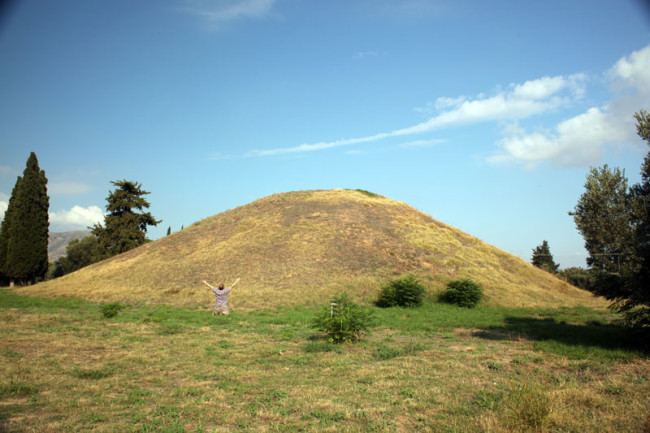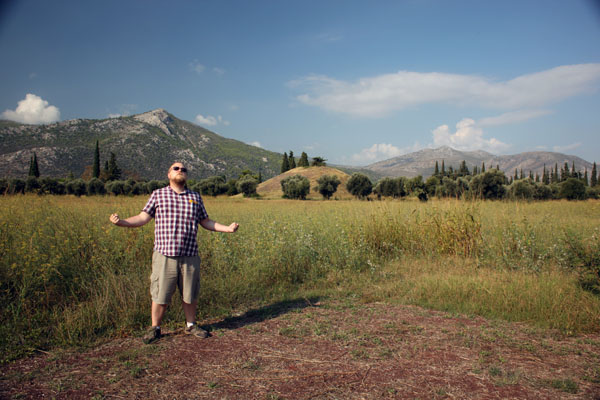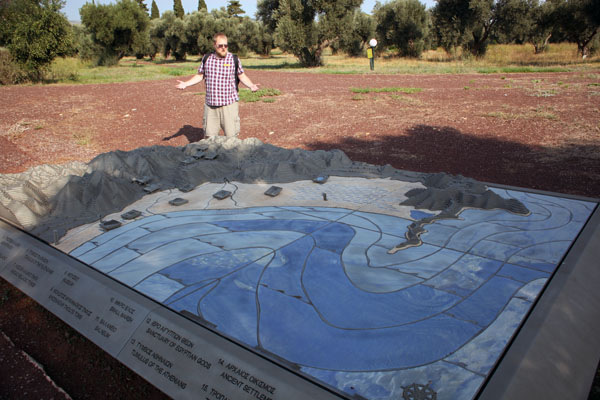
As with many 2500-year-old battlefields, most of Marathon is the victim of development. Although historians continue to debate over the exact positions of the Greek and Persian armies in 490 BC, the reality is that modern buildings and streets cover much of the terrain. Our modern-day concept of preserving battlefields would likely confuse the ancients who had other means for commemorating their warriors. Luckily, several major archaeological discoveries show us how the Greeks commemorated the battle.
Nearly 600 years after the battle, the Greek geographer Pausanias (c. 175 AD) described a grave containing the remains of the Athenians who died at Marathon (Paus. 1.32.3). He also described steles that listed the names of the dead, which certainly is how Herodotus arrived at his exact number of Athenian dead—192. These steles are lost to history, but the mound is still with us.
But how do we know this is the mound containing dead Athenians who fought the Persians that day?
Throughout the 1800s, several archeologists excavated portions of the mound, returning only Persian arrows and pieces of obsidian. It was not until 1890 that they discovered human ashes and charred bones, as well as pottery dating to the early fifth-century BC in this mound. From then on, the consensus has been that this is the tomb of the Athenians from Marathon. ((J. A. G. van der Veer, “The Battle of Marathon: A Topographical Survey,” Mnemosyne 35 (1982): 290.))
Cremating and burying war dead was a custom for the Greeks, which included a feast. For this ceremony, they first laid some sand. On top of that, they made an outline of bricks, roughly 16 by 3 ft. Here, they laid the pyre for cremation. Afterwards, they piled on the dirt to create the massive mound. ((Hammond, N. G. L. “The Campaign and the Battle of Marathon,” The Journal of Hellenic Studies 88 (1968): 15-16.))
Remarkably, Achilles used this same method in the Iliad.
They marked out the grave-mound’s circle, laid a base of stones
upon it around the pyre, then piled on loose earth,
and, the mound once raised, began leaving (Iliad, 23.255-257). ((This translation comes from the Peter Green translation (Oakland: University of California Press, 2015).))
The Athenian mound was much larger 2400 years ago. Yet, even after several millennia of erosion and decapitation from one of the excavations, the mound still stands nearly 30 ft tall, 164 ft in diameter, and more than 600 ft in circumference. ((Hammond 1968, 15.))

If the ceremony was anything like the one portrayed in the Iliad, then there were lengthy orations of the deeds of the men. Given the size of the mound, it would have dominated the landscape, making it easy to find. Later the men who died at Marathon became legends and the Greeks, especially descendants of the fallen warriors would make pilgrimages to the mound. Pausanias recorded such acts 600 years after the battle (1.32.4).
Today, the mound no longer dominates the plain. The Greeks protect it inside a walled park, complete with a sidewalk, modern monuments, and a diorama. It is an ancient piece of history smack dab in the middle of a neighborhood, still well worth the pilgrimage for any Greek or worshiper of history.

